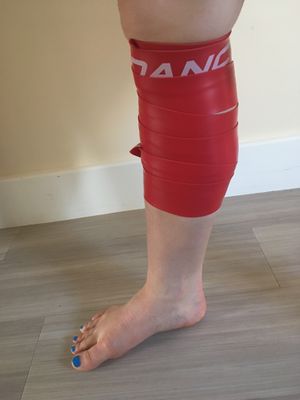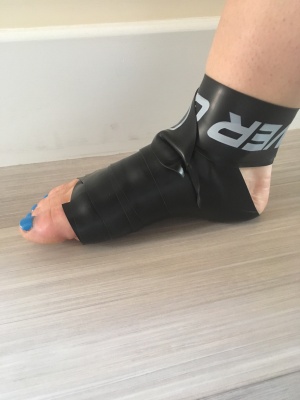Tissue Flossing: Difference between revisions
Claire Knott (talk | contribs) No edit summary |
Claire Knott (talk | contribs) No edit summary |
||
| Line 1: | Line 1: | ||
<div class="editorbox"> | <div class="editorbox"> | ||
'''Abbey Wright '''- Your name will be added here if you created the original content for this page. | '''Abbey Wright '''- Your name will be added here if you created the original content for this page. | ||
</div>'''Top Contributors''' - {{Special:Contributors/{{FULLPAGENAME}}}} | </div>'''Top Contributors''' - {{Special:Contributors/{{FULLPAGENAME}}}} | ||
| Line 15: | Line 16: | ||
* reduced post training/competition muscle soreness | * reduced post training/competition muscle soreness | ||
* improved muscle recovery | * improved muscle recovery | ||
[[File:Floss calf.JPG|left|400x400px|Calf flossing|frameless]] | [[File:Floss calf.JPG|left|400x400px|Calf flossing|frameless]] | ||
[[File:Floss_foot_lateral.JPG|right|frameless|400x400px]] | [[File:Floss_foot_lateral.JPG|right|frameless|400x400px]] | ||
Revision as of 10:48, 19 November 2018
Abbey Wright - Your name will be added here if you created the original content for this page.
Top Contributors - Abbey Wright, Claire Knott, Kim Jackson, Rucha Gadgil, Admin and Tony Lowe
Definition[edit | edit source]
Tissue flossing (mainly known by brand names: RockFloss or Rogue Fitness Voodoo Floss) is an increasingly popular treatment modality. The term is often used simultaneously with Blood Flow Restriction training (BFRT).
BFRT and tissue flossing involve applying an external pressure above or below a muscle or joint of the extremities, typically by using a circumferential, elastic band. The pressure provided by the coiled band safely maintains arterial inflow of blood but reduces or occludes venous outflow distal to the site.
Currently, tissue flossing is not strongly supported by high levels of evidence. Athletes and sporting physiotherapists or practitioners that use tissue flossing techniques seek benefits of:
- reduce pain
- increase range of movement
- improved performance
- injury prevention
- reduced post training/competition muscle soreness
- improved muscle recovery
Theory[edit | edit source]
Most recent studies have looked at the following potential implications of this technique for:
- improving muscle recovery following strength endurance training[1]
- alternative treatment of Osgood-Schlatter's disease[2]
- reduction of delayed onset muscle soreness (DOMS)[3]
- temporary, non-significant, small improvements in jump and sprint performance and ROM when used in the ankle [4][5]
The application of the tissue flossing band under tension causes compression and venous constriction. After removing the compression the re-perfusion of the muscle tissue theoretically improves ROM and decreases pain. [6]
On testing in male athletes with uninjured shoulders there was found to be no significant clinical improvement in ROM or power output. [7]
One study testing a larger cohort of male and female athletes found to be a significant clinical improvement in ankle ROM post treatment as well as an increase in single leg jump height and velocity[6]
Application[edit | edit source]
This treatment can be applied to any appendage to have affect on a painful area or stiff joint. Such as the ankle:
It can also be applied to larger joints such as the shoulder:
The manufacturers recommend not using tissue flossing on back, neck, abdomen or head.
Clinical Implications[edit | edit source]
There is little evidence overall for this technique and of the current evidence, very few studies show either positive or negative support for use of tissue flossing. Additionally, more research is needed into the physiological changes associated with the tissue flossing method.
Resources[edit | edit source]
References[edit | edit source]
- ↑ Gorny V, Stöggl T. Tissue flossing as a recovery tool for the lower extremity after strength endurance intervals. Sportverletzung Sportschaden: Organ der Gesellschaft fur Orthopadisch-Traumatologische Sportmedizin. 2018 Feb.
- ↑ Weber P. Flossing: An alternative treatment approach to Osgood-Schlatter's disease: Case report of an adolescent soccer player. Journal of Bodywork and Movement Therapies. 2018 Oct 1;22(4):860-1.
- ↑ Prill R, Schulz R, Michel S. Tissue flossing: a new short-duration compression therapy for reducing exercise-induced delayed-onset muscle soreness. A randomized, controlled and double-blind pilot cross-over trial. The Journal of sports medicine and physical fitness. 2018 Oct.
- ↑ Driller M, Mackay K, Mills B, Tavares F. Tissue flossing on ankle range of motion, jump and sprint performance: A follow-up study. Physical Therapy in Sport. 2017 Nov 1;28:29-33.
- ↑ Driller MW, Overmayer RG. The effects of tissue flossing on ankle range of motion and jump performance. Physical Therapy in Sport. 2017 May 1;25:20-4.
- ↑ 6.0 6.1 Driller MW, Overmayer RG. The effects of tissue flossing on ankle range of motion and jump performance. Physical Therapy in Sport. 2017 May 1;25:20-4.
- ↑ Plocker D, Wahlquist B, Dittrich B. Effects of tissue flossing on upper extremity range of motion and power. Ininternational journal of exercise Science: Conference proceedings 2015 (Vol. 12, No. 1, p. 37).
- ↑ Rock Tape Go stronger go longer. Rock Tape - RockFloss tutorial - Calf. Available from: https://www.youtube.com/watch?v=L6ygP7rWwb4 [last accessed 27/10/2017]
- ↑ Kinetic Sports Rehab. How to Voodoo Floss your shoulder. Available from: https://www.youtube.com/watch?v=YerDfsn1jcA [last accessed 14.07.2015]








